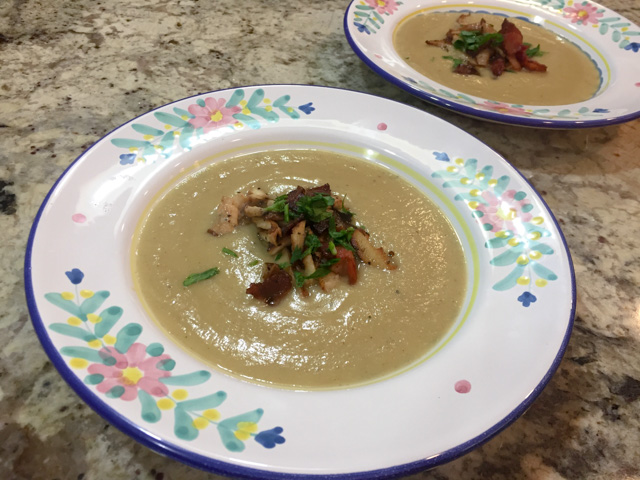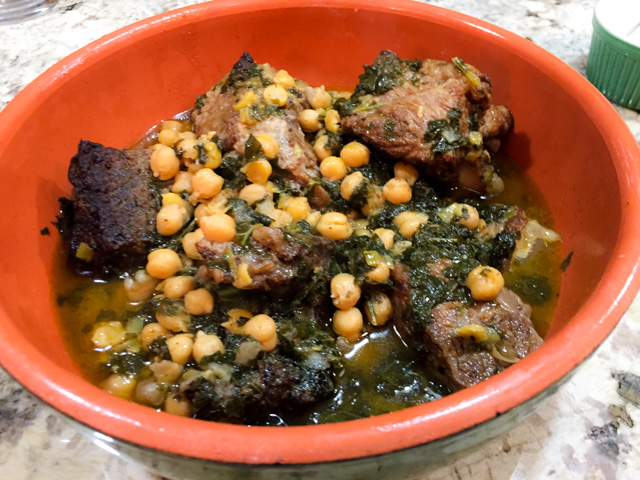In my previous post I mentioned I’ve been mesmerized by all things Middle East. True. But there’s more. I’ve been also enjoying a virtual love affair with the United Kingdom in general and England in particular. A fascination that started many years ago when I got obsessed by Henry VIII. To the classic question ‘which book would you take to a desert island?” my answer comes quickly, The Autobiography of Henry VIII, a masterpiece composed by Margaret George. A real tour de force in historical research and writing. More recently, shows like Outlander, The White Queen, The Tudors, and The Crown have only added to my fascination with the UK. So, when amazon.com suggested The London Cookbook: Recipes from the Restaurants, Cafes, and Hole-in-the-Wall Gems of a Modern City I wasted no time investigating it further. Next thing I knew, it was in my shopping cart. The book, written by Aleksandra Crapanzano, is pretty much a declaration of culinary love to one of the most amazing cities in the world. I’ve been to London a few times, a couple of those super briefly on a weekend break while living in Paris. Reading the book gave me an intense desire to buy a ticket and fly back. With the book in hand, following Aleksandra footsteps. Speaking of it, she opens the book with a nice walking tour that passes by… Ottolenghi’s spot, in search of his legendary Tahini Cookies. A book that starts like that… is a book I must own. Aleksandra was kind enough to allow me to publish a recipe from it, so without further ado, here I go…
SHORT RIBS WITH CHICKPEAS AND CHARD
(published with permission from Aleksandra Crapanzano,
recipe from The London Cookbook).
1 tablespoon sea salt
1 tablespoon ground cumin
1 tablespoon ground caraway
1 tablespoon ground coriander
1 tablespoon smoked paprika
4 pounds bone-in beef short ribs
3 tablespoons vegetable oil
2 yellow onions, thinly sliced
6 cloves garlic, peeled and halved
1 bunch Swiss chard, stems removed, leaves coarsely chopped
2 cups cooked chickpeas
6 cups chicken stock
Salt and pepper, to taste
2 lemons
1 cup labneh or full-fat Greek yogurt
Combine the salt, cumin, caraway, coriander, and paprika. Sprinkle half of the spice mixture over the ribs. Cover loosely with plastic wrap and refrigerate overnight. The next day, pat the ribs dry with paper towels.
Heat the oil in a large sauté pan. Add the ribs and cook for 2 to 3 minutes on each side, until golden brown. If your pan is on the small side, work in batches so as not to overcrowd the pan. Transfer the ribs to a plate, leaving the oil behind. Add the onions to the pan and sauté over a medium-low heat until they are soft and nearly translucent. Stir in the garlic followed by the chard and the remaining spice mixture. Stir and cook for 5 minutes longer. Add the short ribs and chickpeas, pour in the stock, and bring to a boil. Skim any foam that floats to the surface and then lower the heat, partially cover, and simmer for 2 to 3 hours, basting occasionally. The ribs are done when the sauce has thickened and the meat pulls away from the bone. Season with salt and pepper and the juice of 1 lemon. If you have labneh, use it. Otherwise, vigorously whip the yogurt and olive oil together with a fork. Season to taste. Serve the stew with a dollop of labneh and a wedge of lemon.
ENJOY!
to print the recipe, click here
Comments: Short ribs are the definition of comfort food, but when chickpeas and chard are added as supporting actors, you have a show-stopping dish that spells comfort in capital letters. I knew it would be hard to get a good picture, because well, that is the problem with brown food, but allow yourself to go past the photo and trust me, the taste is sublime. Plus, Aleksandra’s choice of labneh to spoon on top fulfills the circle of my fascination, joining Middle East and England in one amazing dish. There’s something about labneh, you must try it if you are a labneh virgin. Easy to make if you cannot find it at your grocery store, just follow Sawsan’s recipe and be ready to be amazed.
And now, a virtual tour of Aleksandra’s book…
First, let me say that she is a delightful writer. She doesn’t simply offer you a recipe, she will show you why that particular restaurant made the cut to be showcased in her book. The quality of the food matters, but it’s clear that behind great food and service you’ll find genuine, hard-working people with the passion to share their cooking with family, friends, and customers. You will read fascinating stories about places that have been in business for a long time… She offers the perfect amount of prose before each recipe, with a nice balance of wit and knowledge. The recipes are for the most part quite straightforward to make at home, Aleksandra often suggests adaptations for ingredients that might be hard to find. As you know, I have no partnership with amazon.com or any other company, and only review cookbooks I fall in love with. This was definitely one of them.
The book is divided in 10 chapters.
Chapter #1 – Light Fare. The first recipe of the chapter is a perfect example of what the book is all about. A wonderful praise of Ruth Rogers, from The River Cafe, the way she runs her restaurant with “no shouting, no swearing, no fear.” The recipe, a Crab and Raw Artichoke Salad. Have you ever considered shaving artichokes to enjoy in its raw form? I had not. Intriguing… Other favorites from the chapter: Potted Shrimp, from Rules, a place dear to my heart, since Phil and I enjoyed two very romantic dinners at Rules years ago; Shrimp Aguachili Seviche with Jalapeno and Citrus; Grilled Leeks, Chevre, Brown Butter & Smoked Almonds. Smoked almonds, now that’s something to dream about. In this chapter you will get to know interesting facts about Ottolenghi, in the introduction to one of his recipes – Mung and Haricots Verts. As Aleksandra puts it, the recipe is “very Ottolenghi.” The mung beans are Asian, the haricots verts French, the spices Indian. The recipe for the classic Welsh Rarebit comes with a delightful description of two gentlemen enjoying it at St. John. All very proper, as you must expect for all things London.
Chapter #2 – Soups. My heart missed a beat with the description of the Fennel and Watercress Soup from Newman Street Tavern. Fennel is like green candy for Aleksandra, and I was left nodding in full approval. She mentions walking in blizzard-like conditions in New York to get some fennel juice at City Bakery, and that made me want to go to London with a stop at JFK with enough hours to allow for a quick Uber drive to that spot. If you live in New York, go sip a glass and tell me all about it. She follows with Smoked Paprika, Piquillo Pepper, and Tomato Soup with Chevre Toasts. Yes. To. All. How about Roasted Corn and Chorizo Chowder? But the recipe that had me mesmerized for good was Celeriac and Chanterelle Soup. I made it. I absolutely loved it. Here it is, as a teaser for you. Simply spectacular.

Chapter #3 – Pasta, Rice, and Grains. This whole chapter is a must-cook. Just to give you a couple of examples, consider the Cinnamon-Scented Porcini Duck Ragu, from Mission. If I had easy access to duck meat, I would definitely make it. Another dish that almost made it to my choice to feature the book: Pork Shoulder, Black Pepper, and Mascarpone Ragu. Totally understandable, right? But maybe the very best is a Chestnut Straccetti with Mushrooms and Chestnuts. You make the pasta from scratch using chestnut flour. OMG. Her description says it all: This dish is, quite simply, a knockout. The photo, folks, the photo is almost too much to stand. You need to host a dinner party for your very best friends and bring that to the table.
Chapter #4 – Vegetarian.
This session opens with Spiced Heritage Carrots, Freekeh, and Labneh, which prompted her profession of love for cardamon, which I totally share. In fact, I also open the jar and take a good sniff just for the pleasure of it. It makes me feel like riding on a magic carpet to far away lands. This recipe has my name written all over it and I know I’ll be making it soon. It follows with Roasted Squash, Braised Lentils, Soft-Boiled Egg, Garlic Yogurt, and Dukka. A symphony. Potato Chaat with Pomegranate, Mint, and Rose Raita also quite enticing to me, and apparently to everyone who dines at Gymkhana: almost everyone who walks through the door of Gymkhana orders this potato chaat before even being shown to a table. Talk about endorsement!
Chapter #5 – Seafood. Scallops with Corn Puree and Chile Oil is maybe my favorite choice in this nice chapter. Of course, she includes the classic Fish and Chips, her version coming from Tom’s Kitchen. In her words: They are indisputable. A fact of British life. “Since the days of Charles Dickens and his chips with reluctant drops of oil“. How cool is that? But there’s also Sugar-Brined Salmon with Radish, Cucumber, and Pea Shoot Salad, Ginger and Cilantro Spiced Cod with Cauliflower Couscous (love this one!), or my favorite fish in the world, Sea Bass with Hot Paprika Vinaigrette, from Moro a must-visit restaurant.
Chapter #6 – Fowl. I would gladly cook (or eat) every single one of the recipes in this chapter. Period. It starts with Chicken Scaloppine with Mushrooms and Marsala, you simply cannot go wrong with that. But how about Indian Chicken and Pumpkin Curry? In fact, the chef behind that recipe, Mark Hix, from Tramshed, was one of the first to offer recipes, encouragement and introductions to Aleksandra when she started her research for this book. Chicken Berry Britannia is a very interesting recipe too, the name pays tribute to a very famous place, Bombay’s Britannia. Americans will flip for Buttermilk Fried Chicken in Pine Salt. Yes, pine salt. Or some Honey-Glazed Duck Breast with Roasted Plums and Bok Choy.
Chapter #7 – Meat. The recipe I shared with you comes from this chapter, obviously. The chapter is full of unusual recipes, counting three different takes for the fashionable pork belly: Kakuni (Japanese Braised Pork Belly), Ottolenghi’s Pork Belly with Apple and Yuzu Puree with Black Bean Sauce, and finally Treacle-Cured Pork Belly. You will also find the super classic Beef Strogonoff, a version coming from The Delaunay. Her words: strogonoff has lost its reputation, having appeared too often and never well, on one too many cafeteria lines and airplane trays. So true! This recipe will do away with unpleasant memories… I should try it, as Beef Strogonoff is a favorite of ours.
Chapter #8 – Desserts.

I would make every single one of the recipes. There, I said it. And I don’t even like sweets that much. Starting with Chocolate Nemesis, described as “this is the real thing.” But how about Ras El Hanout and Buttermilk Loaf? Irresistibly intriguing. Muscovado Custard. OMG. My favorite perhaps would be Orange, Mint, and Rose Petal Cake. I almost chose it as featured recipe. Bakewell Tart from Rules also called my name. By the way, did you know that Rules Restaurant opened the same year that Napoleon began his campaign in Egypt? Yeap, 1798, making it the oldest restaurant in London. And was a favorite spot for Clark Gable, Charles Chaplin, amongst others. A total of 22 mouth-watering recipes to choose from in this chapter.
Chapter #9 – Chilled Desserts. Baked Alaska is in there, but the recipe that has me absolutely mesmerized is Black Sesame Panna Cotta. I even bought black sesame paste and intend to try it soon. Her description (and the photo) is enough to make me drool in anticipation. Of course, Orange Blossom and Milk Pudding, Burnt Orange Chocolate Sorbet (swoon!), and Marsala Raisin Ice Cream would be more than welcome to wrap up a dinner party.
Chapter #10 – Cocktails. I confess that the “idea of a cocktail” appeals more to me than actually having one. But if you enjoy them this chapter will be quite amazing. From River Cafe you’ll find White Peach Summer Martini, and Blood Orange Winter Martini. There’s also a Mumbai Martini from Benares, one of the most sophisticated restaurants in London. This particular drink has notes of curry and ginger. Maybe I should turn it into a tea? (just kidding). But, speaking of tea the Cinnamon Bellini would be perfect for tea lovers, as it mixes Assam tea leaves with cinnamon schnapps (Godschlager). Ottolenghi shines in this chapter too, with a Sage and Cardamon Gin with Pineapple and Cloves. All quite enticing!
I hope you enjoyed my little virtual tour of The London Cookbook. Consider making a little place for it on your bookshelf, even if it is a bit crowded, like ours. Or, go Kindle for a guilty-free experience, which is exactly what yours truly did.
Aleksandra, thank you once more for allowing me to publish one recipe from your wonderful book! I simply must go back and go straight to Ottolenghi to grab a nice portion of tahini cookies. Then, keep calm and carry on!
ONE YEAR AGO: Asian-Style Short Ribs
TWO YEARS AGO: Herbed Goat Cheese Souffles
THREE YEARS AGO: Barley Risotto with Peas
FOUR YEARS AGO: Jammin’ Blueberry Sour Milk Pancakes
FIVE YEARS AGO: Scallops with Black Pasta in Orange Cream Sauce
SIX YEARS AGO: Stir-fried Chicken with Creamed Corn
SEVEN YEARS AGO: Potato, Cheddar, and Chive Torpedo



















